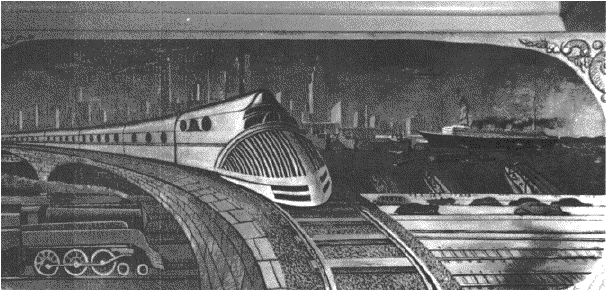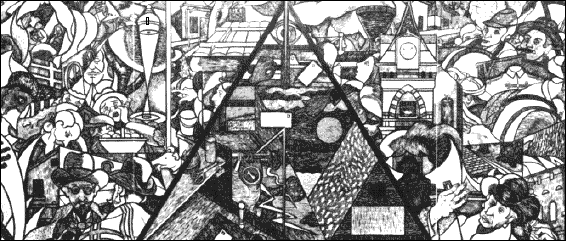
Wall-to-Wall
America
Post Office Murals
In the Great Depression
Karal Ann Marling
(Minnesota)

For nine years, from 1934 to 1943, the Federal Government, under the Public Buildings Administration, commissioned murals for a variety of newly constructed post-offices around the United States. Life magazine, phrase-makers for the western world, named it "Mural America for Rural America."Ms. Marling has researched the workings of what, at the time, was referred to as "WPA art," a program designed to get starving artists out of the garrets and into suitable work that would decorate bare walls, edify the public, and put some spare change in their pockets.
There is a passel of factual material --- descriptions of the murals, how they were conceived, how the artists were chosen, the subjects chosen, how they were monitored, and --- in several instances --- tales of some very juicy controversies that erupted when pictures appeared in their local post office, in some cases, body parts that the locals considered to be obscene or inappropriate to their communities. It was, they usually said, another stupid something dictated by the bureaucrats somewhere off there in Washington.
Professor Marling says that her book is "about taste in the Depression decade." There is some focus on appropriate or inappropriate artistry in selected murals, and there are some wonderful stories of lurid body parts that were changed to meet local taste --- a retouching of a naked bottom here, a breast there --- and in one case, a complete cover up.
Then too, there were some silly changes made because of the whims of the overseers. An artist by the name of Doris Lee prepared sketches for the Post Office Building in Washington that the writer (an art historian by trade) describes as "whimsical." In one case, Lee was told by the Section that
the heads of the figures were too large for their bodies, and...the element of caricature discernible in their faces and postures was unduly blatant.
She was forced to modify them so that the final figures would appear, as Ms. Marling describes it, "vapidly pretty and wholly static."
Frank Mechau's controversial "Dangers of the Mail" in the same building represented
Indians taking special delight in scalping two naked women crawling on their hands and knees across the foreground of the scene...while a third woman, also nude, was being strangled with exquisite deliberation by no fewer than two savages.
This created no little hub-bub and certainly brought up the question --- still much in the air with the NEA --- as to whether the federal government ought to be sponsoring what some saw as paintings that were just a bit too viewer-
friendly. In her choice words on such controversies, we find Professor Marling at her best, but there are times when she seems to be stretching it: for example, her thesis that a Walt Disney cartoon sequence with Mickey Mouse leading a brass band might have some relationship to a mural in Corning, Iowa, called "Band Concert."
§ § §
Naked bodies, attacks on "local values," implied bi-racial tolerance, and antagonism towards what some saw as bizarre --- read "modern" --- art are the themes of this fine book, and on the whole, it is a delight. For instance, the folk in Aiken, South Carolina went bananas over Stefan Hirsch's Justice as Protector and Avenger, because the figure of justice appeared to be a "mulatto" (not to be idolized in the deep south) and because to the right of the lady was a representation of
a burning house, a "shyster" lawyer freeing a prisoner from jail and a burglar pursuing his trade.
A local judge questioned whether the mural was "a work of art" or a "monstrosity." An official of the PBA went to Aiken, took a gander, and subsequently authorized
the purchase of a tan velvet curtain on a drawstring...
to be placed over the mural --- so that it can be covered through court sessions and opened to the public on request. Ms. Marling opines that the wall offended the people of Aiken because they much preferred Hollywood reality, or perhaps Mickey Mouse. It was "a phantom mural for a phantom people who didn't live in Aiken, South Carolina," she concludes.
The most entertaining story of them all concerns a somewhat giddy modernist named Lloyd Ney who came up with a bizarre mural called New London Facets. The service rejected it out-
of- hand because of the very strangeness of it, but Ney took himself off to New London, Ohio, where the work was to be mounted in the local P.O., and by sheer enthusiasm, got the citizens --- including the local Chamber of Commerce --- so worked up in favor of his mural that it came into being. It's a doozey [see below]. In abstract fashion, it shows not only floating postcards and bottles and scissors and an Uncle Sam figure in a fedora, but a local lunatic named "Belle Fontaine," two area physicians who were known to wear shawls in preference to topcoats, and a hippopotamus. Why the beast? Because the first hippopotamus sighted in America had apparently turned up in New London. The whole Ney story is a wonderful sequence in a wonderful book. In fact, Professor Marling's writing is good enough that her tale of the pitfalls of digging through the National Archives in Washington D.C. for the research for Wall-
to- is in itself worthy reading. She reports that some essential parts of material she needed --- photographic records, for example --- could only be found in other offices or other buildings, and once located, may have been useless since some artistsWall America
hired professional photographers to record the work in situ; some had the mural photographed as it hung on stretchers in the studio; some took dreadful pictures with Brownies.
We can empathize with the frustration at this last because despite the fine writing of the author, the hundred or so reproductions in the book are minuscule --- mostly squeezed into a third of a page --- and are entirely in black-and-white. To represent a thirty or sixty foot color mural in such a fashion is painfully inadequate and may force some of us who wouldn't be caught dead in Aiken, South Carolina to go there nonetheless to see what the hell lies behind that tan curtain.

--- L. J. Waters, PhD